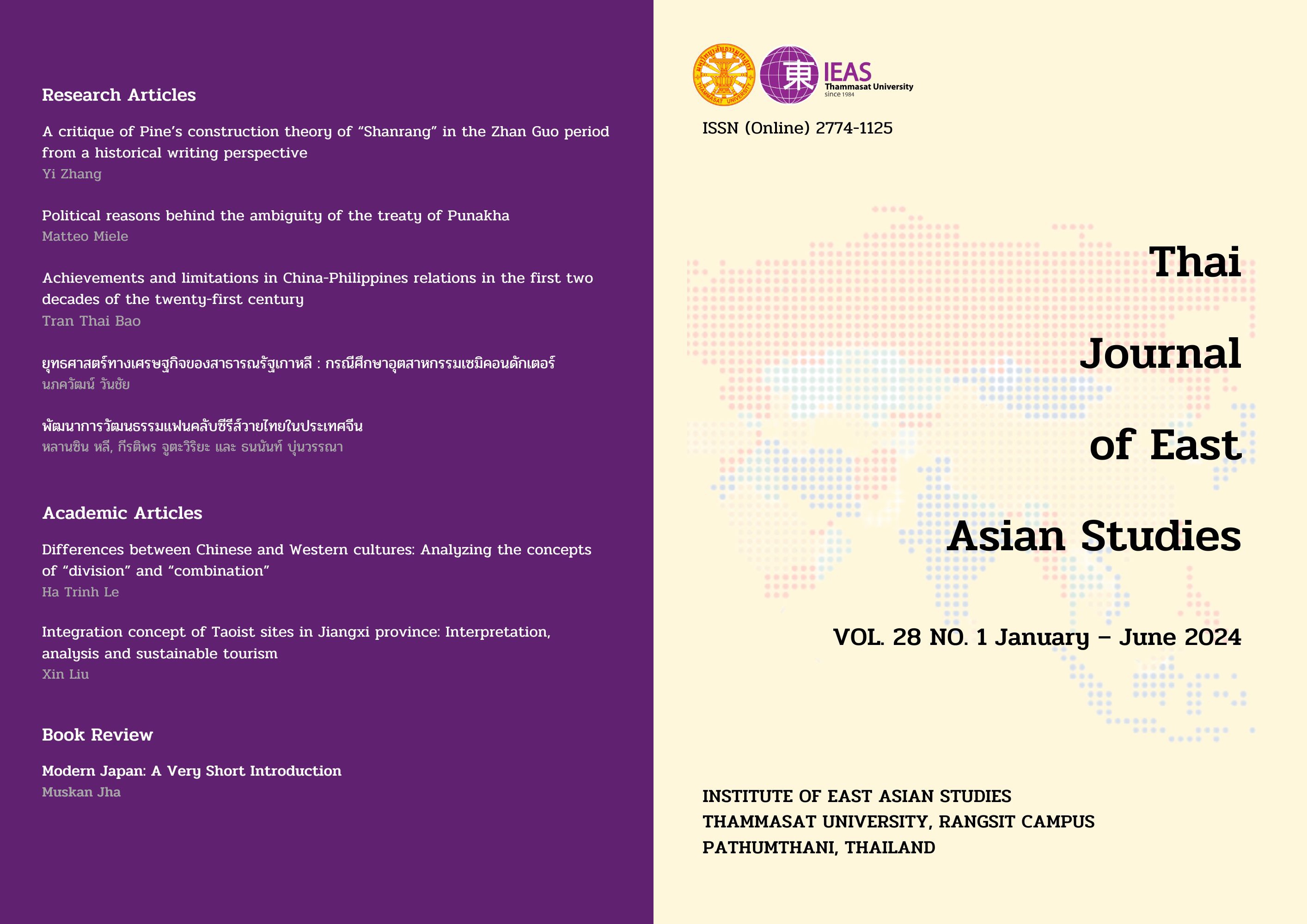Economic Strategy of the Republic of Korea: A Case Study of the Semiconductor Industry
Keywords:
Semiconductor, Geopolitica, Geoeconomics, International political economyAbstract
This research studied factors supporting the economic strategy governing the South Korean semiconductor industry towards a global economic and technological status. Mixed methods research was done with data gathered by trade statistics, market proportions, academic articles, journals, and websites and conceptually analyzed. International political economy (IPE) was the main study framework, focusing on geopolitical and geoeconomic perspective for data analysis. Results were that the semiconductor industry is considered a key determinant in South Korean economic strategy. As semiconductors are considered economic indicators, they reflect economic stability during geopolitical conflicts, including the United States (US)-China technology rivalry, featuring trade sanctions export control and production bases moved from China to avoid Chinese economic coercion. In a geo-economic dimension and cooperation with the US, next generation South Korean chip factories leading the manufacturing process and human resources. These findings underline South Korean economic strategy based on national interest to integrate the semiconductor industry in the global supply chain value.
Downloads
References
สถานเอกอัครราชทูต ณ กรุงโซล. (2565, 29 พฤศจิกายน). จับตายุทธศาสตร์ K-Semiconductor แต้มต่อของอุตสาหกรรมอิเล็กทรอนิกส์ไทยสู่เวทีโลก. https://tinyurl.com/fm5uh7pz
Allison, G., Klyman, K., Barbesino, K., & Yen, H. (2021). The Great Tech Rivalry: China vs the U.S.. Harvard Kennedy School.
Bae, S-O., & Lie, j. (2016). The Coming Crisis of Scientific and Technological Expertise in South Korea. Asian Survey, 56(4), 676-706.
Bloomberg. (2022, August 1). New Chips Act could become a $280 billion boondoggle. https://tinyurl.com/2txfyu5n
Bortoletti, F., & Nguyen, T. (2022, September 30). Vietnam’s Semiconductor Industry: Samsung Makes Further Inroads. Vietnam Briefing. https://tinyurl.com/3ku3fc8r
Capri, A. (2022, August 16). CHIPS on the table: US doubles down on techno-nationalism. Hinrich Foundation. https://tinyurl.com/2vffwmak
Chen, H. J., & Jan, S. T. (2005). A System Dynamics Model of the Semiconductor Industry Development in Taiwan. Journal of the Operational Research Society, 56(10), 1141-1150.
Chiao, J. (2022, April 25). Localization of Chip Manufacturing Rising. Taiwan to Control 48% of Global Foundry Capacity in 2022, Says TrendForce. TrendForce. https://www.trendforce.com/presscenter/news/20220425-11204.html
Cho, D.-S., Kim, D.-J., & Rhee, K. D. (1998). Latecomer Strategies: Evidence from the Semiconductor Industry in Japan and Korea. Organization Science, 9(4), 489-505.
Digitimes. (2022, April 20). Who dominates the global semiconductor market?. https://www.digitimes.com/news/a20220419VL207/geopolitics-semiconductor.html
Fernández-Villaverde, J. (2023, February 28). The Semiconductor Industry and the Future of the World Economy (Part I). Public Discourse. https://tinyurl.com/yzc5tx3b
Hochberg, M., & Hochberg, L. (2022). The semiconductor industry and the China challenge. AsiaTimes. https://asiatimes.com/2022/12/the-semiconductor-industry-and-the-china-challenge/.
Invest Korea. (n.d.). Semiconductor. https://www.investkorea.org/ik-en/cntnts/i-312/web.do
Kang, J. G. (2023, May 29). S.Korean chips’ heavy reliance on China, US poses risk to national economy. The Korea Economic Daily. https://tinyurl.com/ycxfvnvy
Kim, J. H., Yoo, S., & Kim, J. Y. (2023). South Korea’s Nationwide Effort for AI Semiconductor Industry. Communications of the ACM, 66(7), 46-51.
Kim, J., & Kim, E. M. (2006). Erosion of A Developmental State: A Case Study of South Korea’s Semiconductor Industry. Asian International Studies Review, 7(2), 37-59.
Kim, L. (1997). The dynamics of Samsung’s Technological Learning in Semiconductors. California Management Review, 39(3), 86-100.
Kurecic, P. (2015). Geoeconomic and Geopolitical Conflicts: Outcomes of the Geopolitical Economy in a Contemporary World. World Review of Political Economy, 6(4), 522-543.
Kyung, H. (2023). The Age of Economic Security: The Future of Strategic Industries and Korea’s Response. Korea Institute for Industrial Economics and Trade Research Paper, 23, 1-17.
Kyung, H. & Lee, J. (2023). Changes in Semiconductor Geopolitics and the Way Forward for Korea. Korea Institute for Industrial Economics and Trade Research Paper No. 22/MER/07-02. KIET Monthly Industrial Economics, 28. https://dx.doi.org/10.2139/ssrn.4315610
Lee, S. (2022, April 5). Samsung announces research projects for $40.12 million sponsorship. Pulse. https://pulsenews.co.kr/view.php?year=2022&no=305553
Luo, Y., & Van Assche, A. (2023). The rise of techno-geopolitical uncertainty: Implications of the United States CHIPS and Science Act. Journal of International Business Studies, 54, 1423–1440.
Miller, C. (2022). Chip War: The Fight for the World’s Most Critical Technology. Simon & Schuster.
Moffitt, B. (2016). The global rise of populism: Performance, political style, and representation. Stanford University Press.
Na, E. (2022, January 13). South Korea’s supply chain reliance on China leaves it more exposed than the US, Japan: report. South China Morning Post. https://tinyurl.com/5n94a44e
O’Brien, R., & Marc, W. (2010). Global Political Economy. Palgrave Macmillan.
Park, C. (2022, July 19). Anticipating a U.S.-South Korea Semiconductor Alliance. CFR. https://www.cfr.org/blog/anticipating-us-south-korea-semiconductor-alliance
Porter, M. E. (1990). The Competitive Advantages of Nations. Harvard Business Review.
Reuters. (2023, June 8). South Korea vows support for its chip sector amid China-US tension. https://www.reuters.com/technology/south-korea-vows-support-its-chip-sector-amid-china-us-tensions-2023-06-08/
Rousselot, S. (2022, November 16). The Ambiguous Position of the South Korean Semiconductor Industry in the US-China Tech War. Asia Power Watch. https://tinyurl.com/59sfr73d
Segal, T. (2022, September 13). What Is a Semiconductor and How Is It Used?. Investopedia. https://www.investopedia.com/terms/s/semiconductor.asp.
Simonelli, D., Hundt, D., & He, B. (2023, May 5). South Korea pushes back against Chinese economic coercion. Eastasiaforum. https://www.eastasiaforum.org/2023/05/05/south-korea-pushes-back-against-chinese-economic-coercion/
Singapore Economic Development Board. (2022, September 3). Southeast Asia’s rising semiconductor fortunes. https://www.edb.gov.sg/en/business-insights/insights/southeast-asia-s-rising-semiconductor-fortunes.html
Stangarone, T. (2023, April 13). The Role of South Korea in the U.S. Semiconductor Supply Chain Strategy. The National Bureau of Asian Research. https://www.nbr.org/publication/the-role-of-south-korea-in-the-u-s-semiconductor-supply-chain-strategy/.
Taillard, M. (2018). Economics and Modern Warfare: The Invisible Fist of the Market. Palgrave Macmillan.
Tan, L. (2023, May 2). SEMI Southeast Asia Helps Region’s Chip Industry Grow Global Footprint. SEMI. https://www.semi.org/en/blogs/semi-news/semi-southeast-asia-helps-regions-chip-industry-grow-global-footprint
Trade. (2022, November 11). Japan - Country Commercial Guide. https://www.trade.gov/country-commercial-guides/japan-semiconductors.
Weiss, J. C., & Wallace, J. L. (2021). Domestic politics, China’s rise, and the future of the liberal international order. International Organization, 75(2), 635-664.
Zaman, R. (2022, March 17). Semiconductor Value Chain – globally distributed ecosystem. The Waves. https://www.the-waves.org/2022/03/17/semiconductor-value-chain-globally-distributed-ecosystem/
Downloads
Published
How to Cite
Issue
Section
License
Copyright (c) 2024 Thai Journal of East Asian Studies

This work is licensed under a Creative Commons Attribution-NonCommercial-NoDerivatives 4.0 International License.



